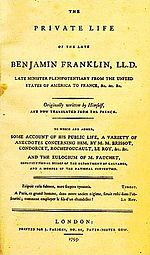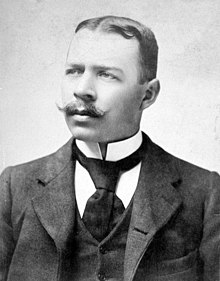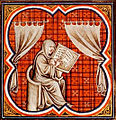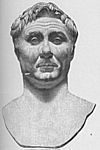Portal:Biography
The Biography Portal
A biography, or simply bio, is a detailed description of a person's life. It involves more than just basic facts like education, work, relationships, and death; it portrays a person's experience of these life events. Unlike a profile or curriculum vitae (résumé), a biography presents a subject's life story, highlighting various aspects of their life, including intimate details of experience, and may include an analysis of the subject's personality.
Biographical works are usually non-fiction, but fiction can also be used to portray a person's life. One in-depth form of biographical coverage is called legacy writing. Works in diverse media, from literature to film, form the genre known as biography.
An authorized biography is written with the permission, cooperation, and at times, participation of a subject or a subject's heirs. An autobiography is written by the person themselves, sometimes with the assistance of a collaborator or ghostwriter. (Full article...)
Featured biographies –
Douglas Robert Jardine (23 October 1900 – 18 June 1958) was an English cricketer who played 22 Test matches for England, captaining the side in 15 of those matches between 1931 and 1934. A right-handed batsman, he is best known for captaining the English team during their successful 1932–33 Ashes tour of Australia. During that series, England employed "Bodyline" tactics against the Australian batsmen, headed by Donald Bradman, wherein bowlers pitched the ball short on the line of leg stump to rise towards the bodies of the batsmen in a manner that some contemporary players and critics viewed as intimidatory and physically dangerous. As captain, Jardine was the person responsible for the implementation of Bodyline.
A controversial figure among cricketers, partially for what was perceived by some to be an arrogant and patrician manner, he was well known for his dislike of Australian players and crowds, and thus was unpopular in Australia, especially so after the Bodyline tour. However, many who played under his leadership regarded him as an excellent and dedicated captain. He was also famous in cricket circles for wearing a multi-coloured Harlequin cap. (Full article...)
Edward Oxford (19 April 1822 – 23 April 1900) was an English man who attempted to assassinate Queen Victoria in 1840. He was the first of seven unconnected people who tried to kill her between 1840 and 1882. Born and raised in Birmingham, he showed erratic behaviour which was sometimes threatening or violent. He had a series of jobs in pubs, all of which he lost because of his conduct. In 1840, shortly after being dismissed from yet another pub, he purchased two pistols and fired twice at Queen Victoria and her husband, Prince Albert. No-one was hurt.
Oxford was arrested and charged with high treason. A jury found him not guilty by reason of insanity and he was detained indefinitely at Her Majesty's pleasure at the two State Criminal Lunatic Asylums: first at Bethlem Royal Hospital and then, after 1864, Broadmoor Hospital. Visitors and staff did not consider him insane. (Full article...)
General Sir Henry George Chauvel, GCMG, KCB (16 April 1865 – 4 March 1945) was a senior officer of the Australian Imperial Force who fought at Gallipoli and during the Sinai and Palestine Campaign in the Middle Eastern theatre of World War I. He was the first Australian to attain the rank of lieutenant general and later general, and the first to lead a corps. As commander of the Desert Mounted Corps, he was responsible for one of the most decisive victories and fastest pursuits in military history.
The son of a grazier, Chauvel was commissioned as a second lieutenant in the Upper Clarence Light Horse, a unit organised by his father, in 1886. After the family moved to Queensland he was commissioned as a second lieutenant in the Queensland Mounted Infantry in 1890, and saw service during the 1891 Australian shearers' strike. He became a regular officer in 1896, and went to the United Kingdom as part of the Queensland contingent for the 1897 Diamond Jubilee of Queen Victoria. In 1899 he commanded one of two companies of Queensland Mounted Infantry that were Queensland's initial contribution to the Boer War. After the war, he was closely involved with the training of the Australian Light Horse. (Full article...)
James Francis Thorpe (Sac and Fox languages: Wa-Tho-Huk, translated as "Bright Path"; May 22 or 28, 1887 – March 28, 1953) was an American athlete and Olympic gold medalist. A member of the Sac and Fox Nation, Thorpe was the first Native American to win a gold medal for the United States in the Olympics. Considered one of the most versatile athletes of modern sports, he won two Olympic gold medals in the 1912 Summer Olympics (one in classic pentathlon and the other in decathlon). He also played football (collegiate and professional), professional baseball, and professional basketball.
He lost his Olympic titles after it was found he had been paid for playing two seasons of semi-professional baseball before competing in the Olympics, thus violating the contemporary amateurism rules. In 1983, 30 years after his death, the International Olympic Committee (IOC) restored his Olympic medals with replicas, after ruling that the decision to strip him of his medals fell outside of the required 30 days. Official IOC records still listed Thorpe as co-champion in decathlon and pentathlon until 2022, when it was decided to restore him as the sole champion in both events. (Full article...)
Clement "Clem" Hill (18 March 1877 – 5 September 1945) was an Australian cricketer who played 49 Test matches as a specialist batsman between 1896 and 1912. He captained the Australian team in ten Tests, winning five and losing five. A prolific run scorer, Hill scored 3,412 runs in Test cricket—a world record at the time of his retirement—at an average of 39.21 per innings, including seven centuries. In 1902, Hill was the first batsman to make 1,000 Test runs in a calendar year, a feat that would not be repeated for 45 years. His innings of 365*, scored against New South Wales for South Australia in 1900–01, was a Sheffield Shield record for 27 years. The South Australian Cricket Association named a grandstand at the Adelaide Oval in his honour in 2003 and he was inducted into the Australian Cricket Hall of Fame in 2005. Hill is regarded as one of the best batsman of his era.
A stocky left-handed batsman, Hill had a crouched, somewhat awkward stance. He gripped the bat low on the handle, playing with a strong bottom hand. His batting style was nonetheless attractive and effective and he was especially strong on the leg side and when cutting. Able to score quickly when required, he was also recognised for his patience and strong defence. Hill normally batted at No. 3 and, along with his contemporary Victor Trumper, he was a mainstay of the Australian batting line-up in the early years of the 20th century. Hill had a strong throwing arm and was an excellent outfielder. He was a popular team-mate and captain, respected for his directness, honesty and cheerfulness. (Full article...)

The murder of Julia Martha Thomas, dubbed the "Barnes Mystery" or the "Richmond Murder" by the press, was one of the most notorious crimes in the Victorian period of the United Kingdom. Thomas, a widow in her 50s who lived in Richmond, London, was murdered on 2 March 1879 by her maid Kate Webster, a 30-year-old Irishwoman with a history of theft. Webster disposed of the body by dismembering it, boiling the flesh off the bones, and throwing most of the remains into the River Thames.
It was alleged, although never proven, that Webster had offered the fat to a publican, neighbours and street children as dripping and lard. Part of Thomas's remains were subsequently recovered from the river. Her severed head remained missing until October 2010, when the skull was found during building works being carried out for Sir David Attenborough. (Full article...)
Henry William Murray, VC, CMG, DSO & Bar, DCM (1 December 1880 – 7 January 1966) was an Australian grazier, soldier, and a recipient of the Victoria Cross, the highest decoration for gallantry "in the face of the enemy" that can be awarded to members of the British and Commonwealth armed forces. Decorated several times throughout his service in the First World War, Murray rose from the rank of private to lieutenant colonel in three and a half years. He is often described as the most highly decorated infantry soldier of the British Empire during the First World War.
Born in Tasmania, Murray worked as a farmer, courier and timber cutter before enlisting in September 1914. Assigned to a machine gun crew, he served during the Gallipoli Campaign, where he was awarded the Distinguished Conduct Medal before the withdrawal from the peninsula. He was later transferred along with the rest of his battalion to France for service on the Western Front, where he was awarded the Distinguished Service Order during the Battle of the Somme. In February 1917, Murray commanded a company during the battalion's attack on the German position of Stormy Trench. During the engagement, the company was able to capture the position and repulse three fierce counter-attacks, with Murray often leading bayonet and bombing charges himself. For his actions during the battle, Murray was awarded the Victoria Cross. Soon after his Victoria Cross action, he was promoted to major and earned a Bar to his Distinguished Service Order during an attack on the Hindenburg Line near Bullecourt. Promoted to lieutenant colonel in early 1918, he assumed command of the 4th Machine Gun Battalion, where he would remain until the end of the war. (Full article...)
















































